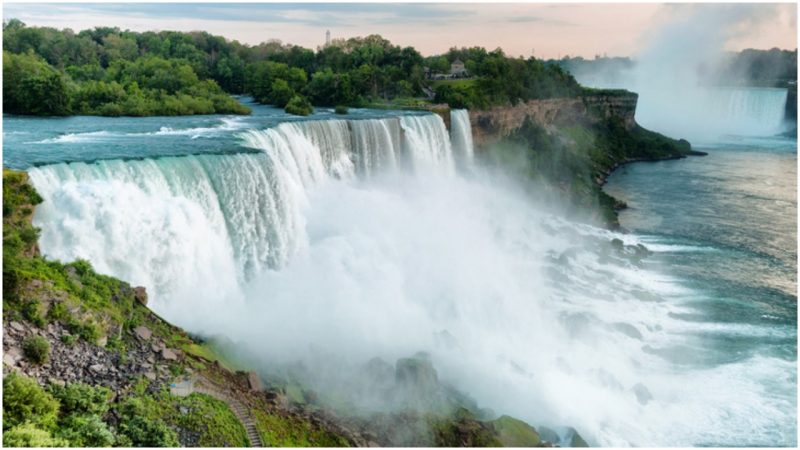Did you hear about the time a bunch of animals–most of them in cages–were put in a boat and sent over the thundering abyss of Niagara Falls? It’s just as well if you haven’t. It wasn’t a shining moment in the history of tourism promotions.
The year was 1827 and a group of hotel owners thought the magnificence of the massive waterfall itself just wasn’t enough.
One of them, William Forsyth of the Pavilion Hotel, bought a condemned lake schooner called The Michigan, and with the help of General Parkhurst Whitney of the Eagle Hotel and John Brown of the Ontario, they began advertising their scheme. On both sides of the U.S.-Canada border, printed sheets of their plan were distributed. The announcement was intriguing enough: “The pirate Michigan with a cargo of ferocious wild animals will pass the great rapids and falls of Niagara–8th September 1827 at 6 o’clock.”
Stunning footage of Niagara Falls in the mist
The Michigan was no pirate vessel. It had been used for years as a merchant ship on Lake Erie, but time had taken a toll and it had been condemned. The ship was festooned in pirate fashion, and human dummies were tied around the deck to help pull off the look.
The three hotel operators said they would take living animals from area forests, put them on board, send them through the forbidding whitewater leading up to the falls and then send the whole shebang over the edge.
The men contended that if the ship followed a course through the deepest waters, it could nimbly handle Horseshoe Falls, the largest of the three falls that group to form Niagara.
The advertised animals were almost like a Wizard of Oz lineup: panthers, wild cats, and wolves–oh my! They were said to be young and of superior musculature so that a great many were expected to survive the horrendous trip. The actual animals documented were a buffalo, two small bears, two raccoons, a dog, and a goose. A few reports from the day also noted two fox, 15 geese, and one eagle.
On the appointed day, the animals were assembled and visitors were allowed to board the boat and view them. The total crowd was estimated at around 10,000 people. Then the vessel was towed from Black Rock to Navy Island, pointed to the falls and released, rocking in the boiling and perilous waters. At the rapids, the hull was torn open and the two bears escaped, swimming to Goat Island. But the others were tied or caged.
Only a lone goose survived to the base of the falls.
It has been reported as the first tourism promotion ever held at the falls, but it would not be the last. Since then more animals, objects, and humans have gone over, for better or for worse. In 1901, a cat named Lagara was sent over the falls in a barrel and survived. And 1930, a turtle went over the falls in a barrel with its owner, George Stathakis, in a massive barrel. The barrel remained intact but became trapped beneath the falls for hours. When the barrel finally came free, Stathakis had suffocated, but the turtle survived.
Annie Edson Taylor survived her 1901 ride over the falls in a barrel, but reports said she exited the barrel bleeding.
Some rides over the falls are even darker than the plight of the ill-fated Michigan and her poor unwilling crew. It’s estimated that between 1850 and 2011, 5,000 bodies were found at the foot of the falls–most of them suicides. Of the daredevils who have pitted their lives against the waters, the odds aren’t good. Only about 25 percent of them make it.
Terri Likens‘ byline has appeared in newspapers around the world through The Associated Press. She has also done work for ABCNews, the BBC, and magazines that include High Country News, American Profile, and Plateau Journal. She lives just east of Nashville, Tenn.
